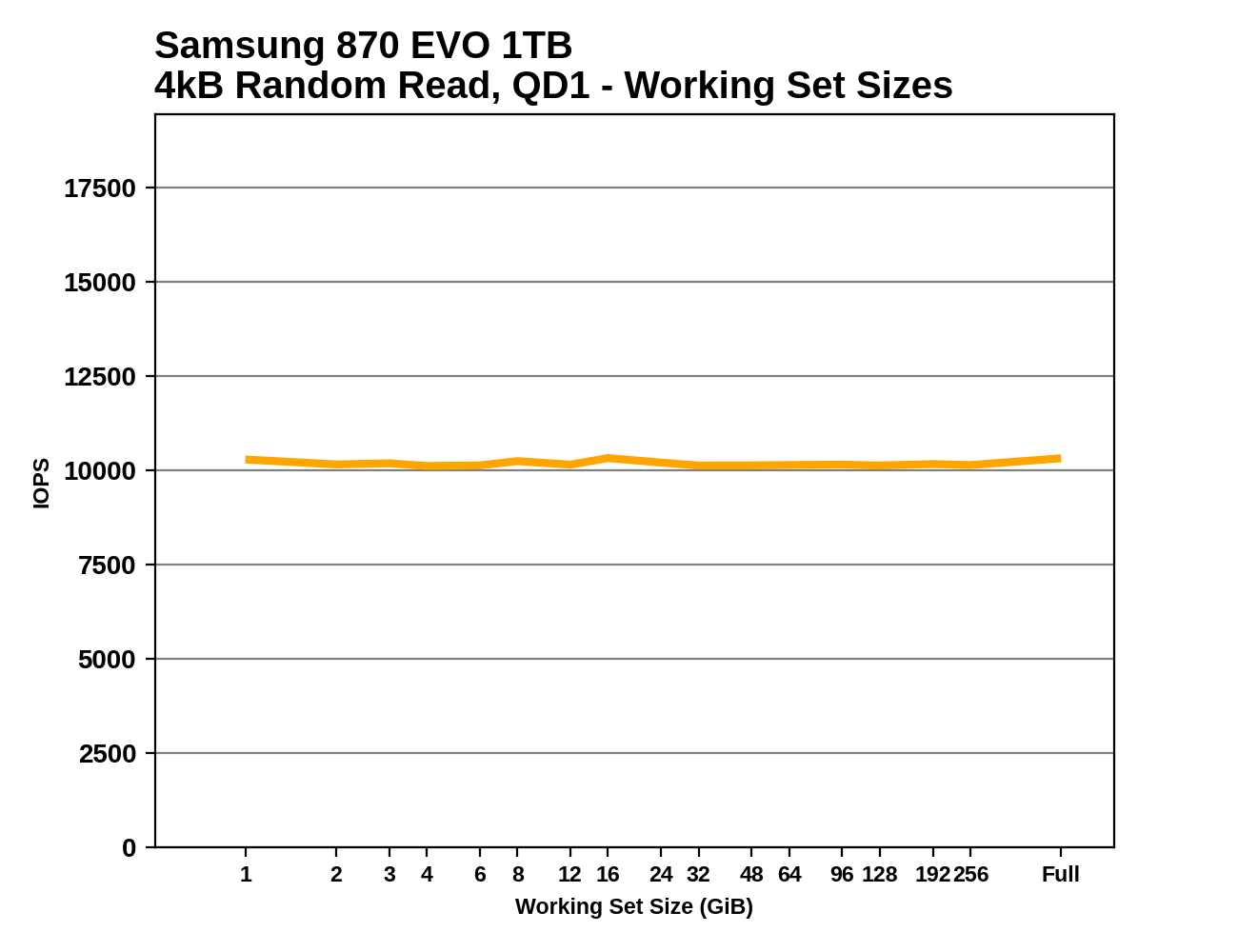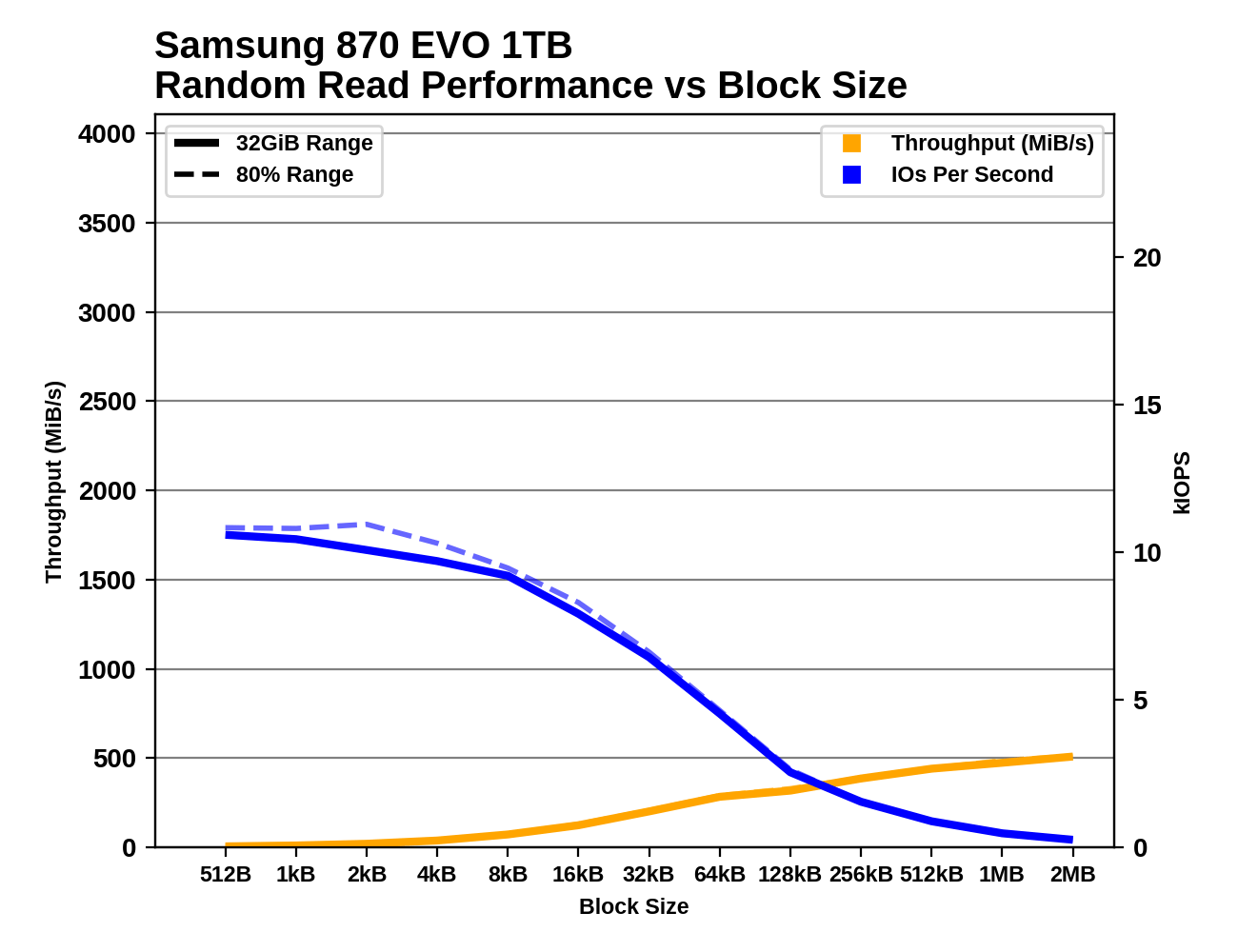The Samsung 870 EVO (1TB & 4TB) Review: Does the World Need Premium SATA SSDs?
by Billy Tallis on February 17, 2021 8:00 AM ESTAdvanced Synthetic Tests
Our benchmark suite includes a variety of tests that are less about replicating any real-world IO patterns, and more about exposing the inner workings of a drive with narrowly-focused tests. Many of these tests will show exaggerated differences between drives, and for the most part that should not be taken as a sign that one drive will be drastically faster for real-world usage. These tests are about satisfying curiosity, and are not good measures of overall drive performance. For more details, please see the overview of our 2021 Consumer SSD Benchmark Suite.
Whole-Drive Sequential Fill
 |
|||||||||
| Pass 1 | |||||||||
| Pass 2 | |||||||||
Some of our other tests have shown a few signs that the 870 EVO's write performance can drop when the SLC cache runs out, but this straightforward sequential write pass over the entire drive doesn't reveal any such behavior. The 870 EVO's sequential write performance is extremely consistent, even on the second write pass.
 |
|||||||||
| Average Throughput for last 16 GB | Overall Average Throughput | ||||||||
Due to the excellent performance consistency, the Samsung 870 EVOs edge out the other SATA drives with marginally higher average sequential write speeds. The entry-level NVMe drives end up much worse off than the mainstream SATA drives once their caches run out, but the more mainstream NVMe drive blows them all away.
Working Set Size
 |
|||||||||
As expected, the Samsung 870 EVO's random read performance shows basically no variation across a range of working set sizes, and that read performance is at least a little bit faster than any of the other SATA drives or the entry-level NVMe drives.
Performance vs Block Sizes
 |
|||||||||
| Random Read | |||||||||
| Random Write | |||||||||
| Sequential Read | |||||||||
| Sequential Write | |||||||||
There are no particular surprises in how the Samsung 870 EVO handles IOs of different block sizes. Unlike some drives, it has no trouble with sub-4kB IOs. It offers moderate improvements over the 860 EVO for mid-sized random reads (up to about 128kB). The one negative is that for writes we again see more inconsistency from the 870 EVO than the 860 EVO when testing an 80% full drive. The simple whole-drive sequential write test may not have been able to reveal any SLC caching troubles, but it does seem clear that the caching behavior has some performance regressions for more complicated workloads on a drive that's more well-used—though it's still unlikely to matter for any typical real-world consumer workload.










136 Comments
View All Comments
Snowleopard3000 - Friday, February 19, 2021 - link
It would be nice to see TLC based 16gb and 32gb SSDs..... look at all that empty space, its not like it is that much more work to do it and it will fit fine.Snowleopard3000 - Friday, February 19, 2021 - link
TB not GBMDD1963 - Friday, February 19, 2021 - link
With my slightly less than 10 TBW typical usage per year based on my 960 EVO, the 4 TB 870 EVO should last me...240 years? :)Oxford Guy - Friday, February 19, 2021 - link
I suppose if you're set on buying a Samsung SATA drive, at least if they're all as bad as the 860 1TB QLC drive that has never been stable in a Zen system.toke - Saturday, February 20, 2021 - link
Isn't SK hynix Gold S31 far better in all graps by a big margin?GeoffreyA - Sunday, February 21, 2021 - link
This will be a silly question no doubt, but is there no way to implement the NVMe protocol over SATA? Or is it not possible circuit-wise and electrically? (I understand that SATA is serial and NVMe is more parallel in nature.) If this could be done, while keeping a legacy mode for older drives, problem solved: the newer interface in the same port, while retaining backwards compatibility. Or would this idea be disastrous?R3Z3N - Friday, February 26, 2021 - link
I really wanted to buy 6 8TB SSDs for my build. Instead I went with 2 PCIE NVME SSDS: 980 Pro 1TB boot drive, Sabrent Rocket 4 Plus 2TB, 4 Sata SSDs in Raid 0 on the mobo, and 6 10TB Exos 3.5 drives in raid 10. I get around 1400MBps read on the Raid 10 and 450MBps write with my Highpoint 3720A HBA. It still is a pain to have to create proxy footage to the NVME drives.... I really really want to replace the HDDs with SSDs sooooo bad.Henry 3 Dogg - Friday, July 9, 2021 - link
"...and power efficiency cannot make big leaps without getting rid of the SATA performance limits."OK, I may be being thick. But that just doesn't seem rational at all.
PushT - Monday, October 18, 2021 - link
"Does the world need premium Sata SSDs?" Every single article, you read the same sentiment, formulated more ore less in the same manner. Do we need Sata ssds ? Yes, we need premium large sized sata ssds, as we have needed premium large size HDDs. Increasingly cheaper bulk storage, with the added benefit of EXTREMELY higher random throughput over HDDs, complying with infrastructures all over the world. What is the point of regurgitating the same cheap one- liner in every single article ?We have all been using NVME for years now, and yes we know its faster, and yes we know it is the future. But have the thermal challenges been solved ? And more interestingly, is the infrastructure around it changing fast enough for Sata to be discontinued ? If Sata was excluded from computer architecture as of now, could the world cope ? Nope. It is and has always been about price versus performace, and as long as we dont see the demise of HDDs I can't imagine why we would see the death of Sata SSDs.
So to the original question: Does the world need premium Sata SSDs ? I think the question is wrong. What the industry is doing is trying to find ways to make cheaper nand that is also just as fast. Price versus performance. 870 Evo is not a premium SSD. It is the commercial sample of experimentation. One final question : Given that PREMIUM ssds will cost you an arm and a leg, would you rather your computer system was a hybrid of nvme/Sata SSD, for ultra fast, large and relatively cheap storage and application - Or would you say a few TBs of the insanely fast and expensive premium NVME at the same price, would solve all your problems ? The answer would be the same for most people in the world. Sorry about the rant but it was a long time coming..
pentaxmx - Thursday, November 25, 2021 - link
interesting. Why the reviewer is disappointed when he found out Crucial MX changed 64 layer to 96 layer? Is 96 layer inferior to 64 layer NAND? Shouldn't that be considered an upgrade???